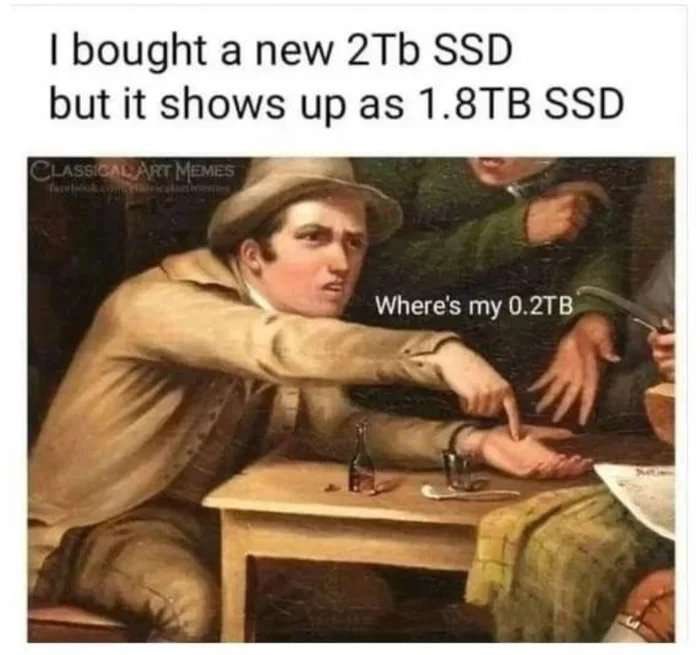this post was submitted on 27 Nov 2023
892 points (96.8% liked)
memes
9373 readers
2185 users here now
Community rules
1. Be civil
No trolling, bigotry or other insulting / annoying behaviour
2. No politics
This is non-politics community. For political memes please go to [email protected]
3. No recent reposts
Check for reposts when posting a meme, you can only repost after 1 month
4. No bots
No bots without the express approval of the mods or the admins
5. No Spam/Ads
No advertisements or spam. This is an instance rule and the only way to live.
Sister communities
- [email protected] : Star Trek memes, chat and shitposts
- [email protected] : Lemmy Shitposts, anything and everything goes.
- [email protected] : Linux themed memes
- [email protected] : for those who love comic stories.
founded 1 year ago
MODERATORS
you are viewing a single comment's thread
view the rest of the comments
view the rest of the comments

The result of marketing pushing base 10 numbers on an archiecture that is base 2. Fundamentally is caused by the difference of 10³ (1000) vs 2¹⁰ (1024).
Actual storage size of what you will buy is Amount = initial size * (1000/1024)^n where n is the power of 10^n for the magnitude (e.g kilo = 3, mega = 6, giga = 9, tera = 12)
Fact: This truth is intentionally manipulation.
OP is right with an applicable staturing the pic.
Solution: Sue the fuck out of all of them. Especially Samsung. Fuck Samsung everything.
its correct, the final size you see in the OS is not kilo/giga/terabytes but kibi/gibi/tebibytes. the problem is less of the drive and more of how the OS displays the value. the OS CHOOSES to display it in base 2, but drives are sold in base 10, and what is given is actually correct. Windows, being the most used one, is the most guilty of starting the trend of naming what should be kibi/gibi/tebibytes as kilo/giga/terabytes. Essentially, 2 Tera Bytes ~= 1.82 Tebibytes. many OS' display the latter but use the former naming
Base 2 based displays and calling them kilobytes date back to the 1960s. Way before the byte was standardised to be eight bits (and according to network engineers it still isn't you still see new RFCs using "octet").
Granted though harddisks seem to have been base-10 based from the very beginning, with the IBM 350 storing five million 6-bit bytes. Window's history isn't in that kind of hardware though but CP/M and DOS, and
dirdisplayed in base 2 from the beginning (page 10):Then, speaking of operating systems with actual harddrive support: In Unix
ls -lhseems to be universally base-2 based (GNU has--sito switch which I think noone ever uses).-h(and-k) are non-standard, you won't find them in POSIX (default is to print raw number of bytes, no units).Technically correct with numbers is the only way to ever be correct, let alone right.